Comprehensive Analysis of E. coli, ESBLs, and Antibiotic Resistance
VerifiedAdded on 2020/05/11
|38
|8126
|189
Report
AI Summary
This report provides a comprehensive overview of Escherichia coli (E. coli) bacteria, focusing on strains that produce Extended Spectrum Beta-Lactamases (ESBLs). It begins with the history and importance of E. coli, its evolution, taxonomy, and characteristics, including its natural habitats and genome. The report then delves into the pathogenesis of E. coli, detailing virulent factors, epidemiology, and various treatment methods. A significant portion is dedicated to ESBLs, covering their resistance mechanisms, the role of plasmids in gene transfer, and the specific challenges posed by ESBL-producing E. coli infections. The report also explores risk factors, vulnerable populations, and the epidemiology of ESBL E. coli, concluding with a summary of key findings and implications. The report is a detailed analysis of E. coli and its resistance to antibiotics, offering valuable insights into the complexities of bacterial infections and their management.
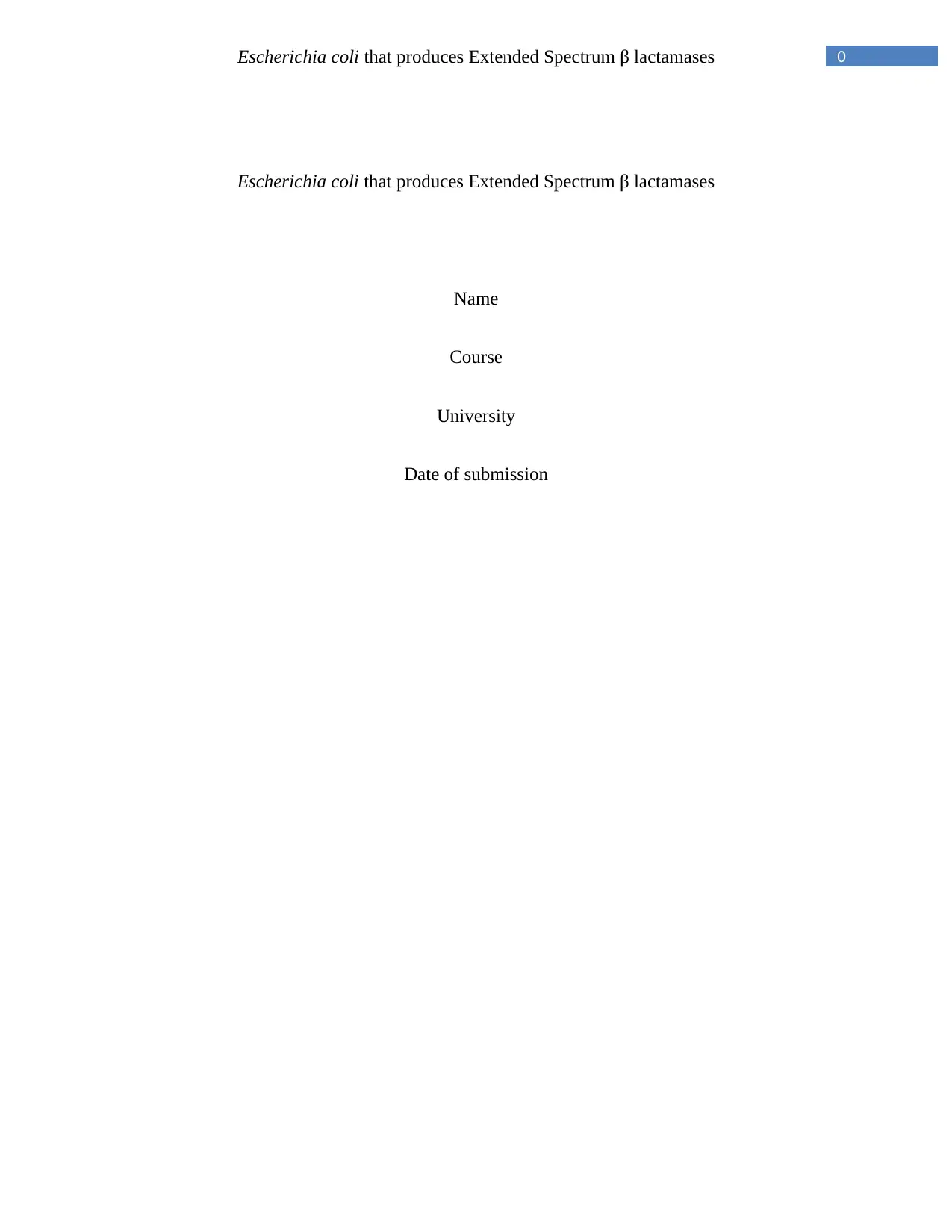
0Escherichia coli that produces Extended Spectrum β lactamases
Escherichia coli that produces Extended Spectrum β lactamases
Name
Course
University
Date of submission
Escherichia coli that produces Extended Spectrum β lactamases
Name
Course
University
Date of submission
Paraphrase This Document
Need a fresh take? Get an instant paraphrase of this document with our AI Paraphraser
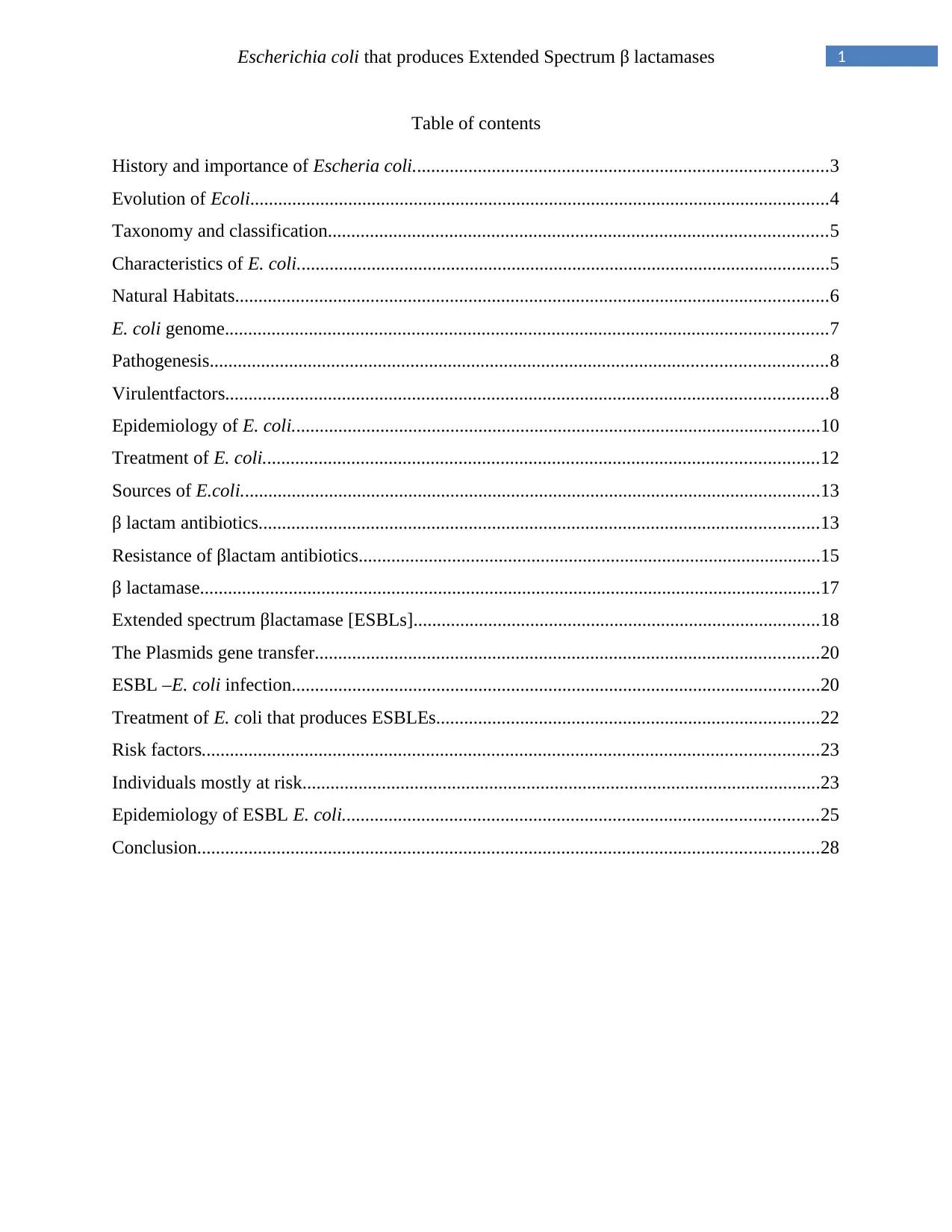
1Escherichia coli that produces Extended Spectrum β lactamases
Table of contents
History and importance of Escheria coli.........................................................................................3
Evolution of Ecoli............................................................................................................................4
Taxonomy and classification...........................................................................................................5
Characteristics of E. coli..................................................................................................................5
Natural Habitats...............................................................................................................................6
E. coli genome.................................................................................................................................7
Pathogenesis....................................................................................................................................8
Virulentfactors.................................................................................................................................8
Epidemiology of E. coli.................................................................................................................10
Treatment of E. coli.......................................................................................................................12
Sources of E.coli............................................................................................................................13
β lactam antibiotics........................................................................................................................13
Resistance of βlactam antibiotics...................................................................................................15
β lactamase.....................................................................................................................................17
Extended spectrum βlactamase [ESBLs].......................................................................................18
The Plasmids gene transfer............................................................................................................20
ESBL –E. coli infection.................................................................................................................20
Treatment of E. coli that produces ESBLEs..................................................................................22
Risk factors....................................................................................................................................23
Individuals mostly at risk...............................................................................................................23
Epidemiology of ESBL E. coli......................................................................................................25
Conclusion.....................................................................................................................................28
Table of contents
History and importance of Escheria coli.........................................................................................3
Evolution of Ecoli............................................................................................................................4
Taxonomy and classification...........................................................................................................5
Characteristics of E. coli..................................................................................................................5
Natural Habitats...............................................................................................................................6
E. coli genome.................................................................................................................................7
Pathogenesis....................................................................................................................................8
Virulentfactors.................................................................................................................................8
Epidemiology of E. coli.................................................................................................................10
Treatment of E. coli.......................................................................................................................12
Sources of E.coli............................................................................................................................13
β lactam antibiotics........................................................................................................................13
Resistance of βlactam antibiotics...................................................................................................15
β lactamase.....................................................................................................................................17
Extended spectrum βlactamase [ESBLs].......................................................................................18
The Plasmids gene transfer............................................................................................................20
ESBL –E. coli infection.................................................................................................................20
Treatment of E. coli that produces ESBLEs..................................................................................22
Risk factors....................................................................................................................................23
Individuals mostly at risk...............................................................................................................23
Epidemiology of ESBL E. coli......................................................................................................25
Conclusion.....................................................................................................................................28
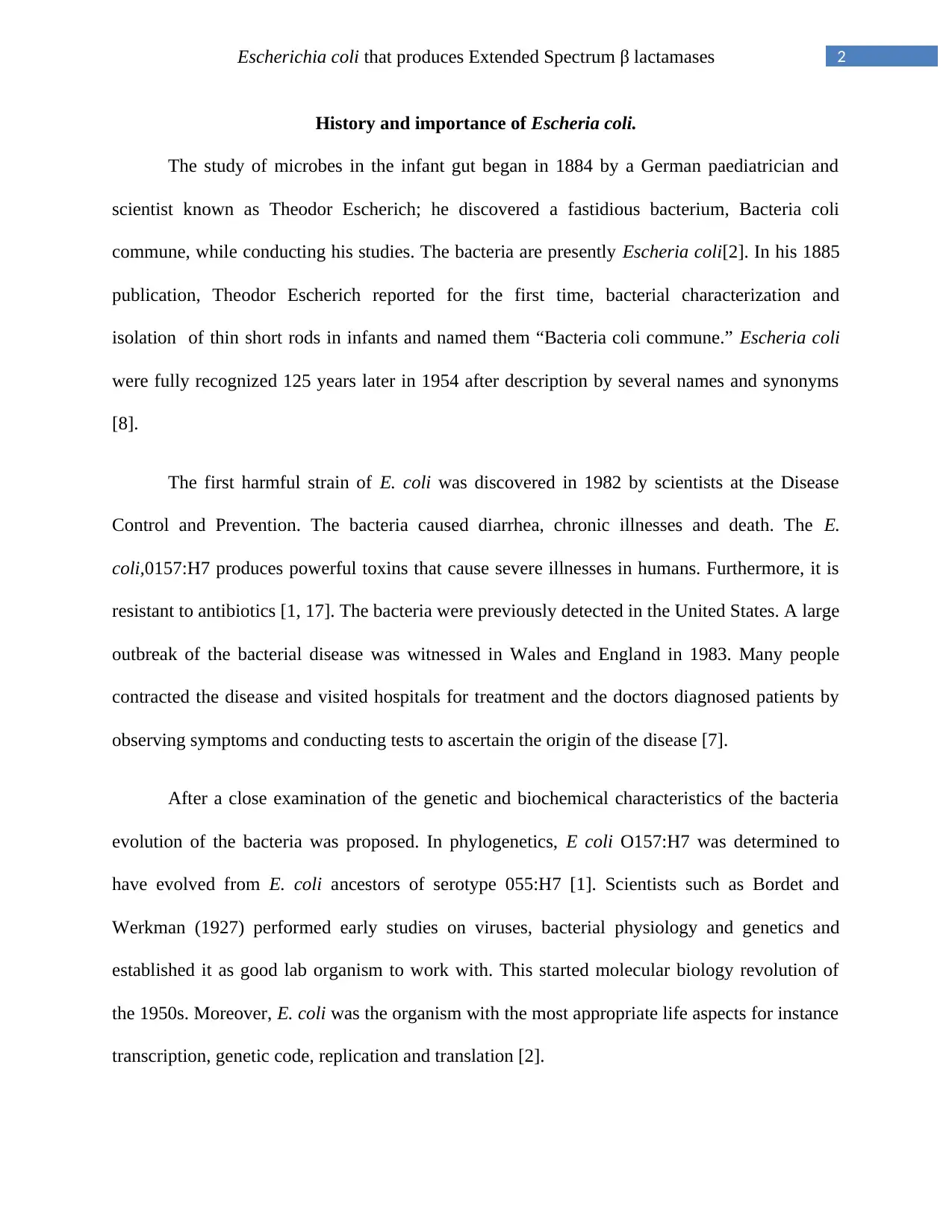
2Escherichia coli that produces Extended Spectrum β lactamases
History and importance of Escheria coli.
The study of microbes in the infant gut began in 1884 by a German paediatrician and
scientist known as Theodor Escherich; he discovered a fastidious bacterium, Bacteria coli
commune, while conducting his studies. The bacteria are presently Escheria coli[2]. In his 1885
publication, Theodor Escherich reported for the first time, bacterial characterization and
isolation of thin short rods in infants and named them “Bacteria coli commune.” Escheria coli
were fully recognized 125 years later in 1954 after description by several names and synonyms
[8].
The first harmful strain of E. coli was discovered in 1982 by scientists at the Disease
Control and Prevention. The bacteria caused diarrhea, chronic illnesses and death. The E.
coli,0157:H7 produces powerful toxins that cause severe illnesses in humans. Furthermore, it is
resistant to antibiotics [1, 17]. The bacteria were previously detected in the United States. A large
outbreak of the bacterial disease was witnessed in Wales and England in 1983. Many people
contracted the disease and visited hospitals for treatment and the doctors diagnosed patients by
observing symptoms and conducting tests to ascertain the origin of the disease [7].
After a close examination of the genetic and biochemical characteristics of the bacteria
evolution of the bacteria was proposed. In phylogenetics, E coli O157:H7 was determined to
have evolved from E. coli ancestors of serotype 055:H7 [1]. Scientists such as Bordet and
Werkman (1927) performed early studies on viruses, bacterial physiology and genetics and
established it as good lab organism to work with. This started molecular biology revolution of
the 1950s. Moreover, E. coli was the organism with the most appropriate life aspects for instance
transcription, genetic code, replication and translation [2].
History and importance of Escheria coli.
The study of microbes in the infant gut began in 1884 by a German paediatrician and
scientist known as Theodor Escherich; he discovered a fastidious bacterium, Bacteria coli
commune, while conducting his studies. The bacteria are presently Escheria coli[2]. In his 1885
publication, Theodor Escherich reported for the first time, bacterial characterization and
isolation of thin short rods in infants and named them “Bacteria coli commune.” Escheria coli
were fully recognized 125 years later in 1954 after description by several names and synonyms
[8].
The first harmful strain of E. coli was discovered in 1982 by scientists at the Disease
Control and Prevention. The bacteria caused diarrhea, chronic illnesses and death. The E.
coli,0157:H7 produces powerful toxins that cause severe illnesses in humans. Furthermore, it is
resistant to antibiotics [1, 17]. The bacteria were previously detected in the United States. A large
outbreak of the bacterial disease was witnessed in Wales and England in 1983. Many people
contracted the disease and visited hospitals for treatment and the doctors diagnosed patients by
observing symptoms and conducting tests to ascertain the origin of the disease [7].
After a close examination of the genetic and biochemical characteristics of the bacteria
evolution of the bacteria was proposed. In phylogenetics, E coli O157:H7 was determined to
have evolved from E. coli ancestors of serotype 055:H7 [1]. Scientists such as Bordet and
Werkman (1927) performed early studies on viruses, bacterial physiology and genetics and
established it as good lab organism to work with. This started molecular biology revolution of
the 1950s. Moreover, E. coli was the organism with the most appropriate life aspects for instance
transcription, genetic code, replication and translation [2].
⊘ This is a preview!⊘
Do you want full access?
Subscribe today to unlock all pages.

Trusted by 1+ million students worldwide
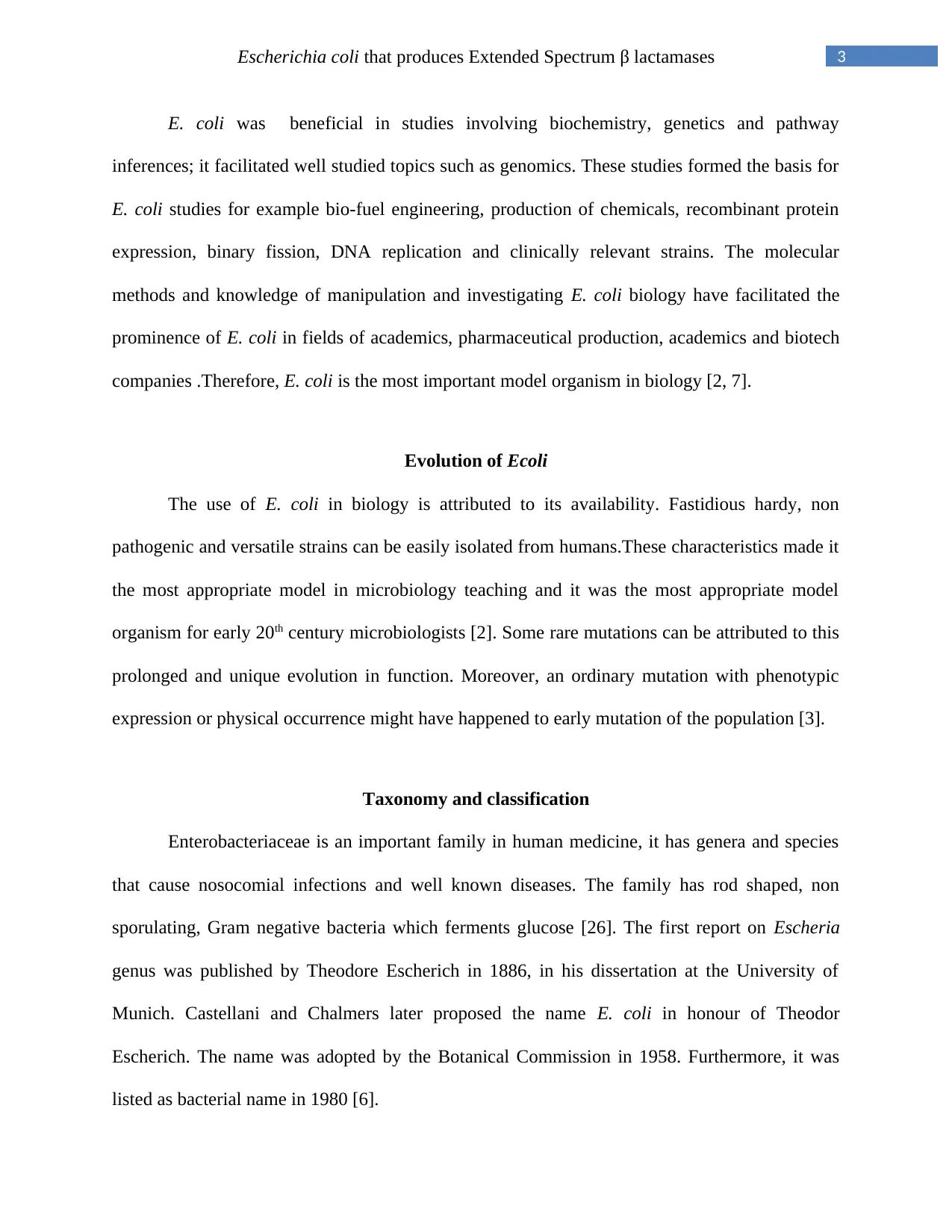
3Escherichia coli that produces Extended Spectrum β lactamases
E. coli was beneficial in studies involving biochemistry, genetics and pathway
inferences; it facilitated well studied topics such as genomics. These studies formed the basis for
E. coli studies for example bio-fuel engineering, production of chemicals, recombinant protein
expression, binary fission, DNA replication and clinically relevant strains. The molecular
methods and knowledge of manipulation and investigating E. coli biology have facilitated the
prominence of E. coli in fields of academics, pharmaceutical production, academics and biotech
companies .Therefore, E. coli is the most important model organism in biology [2, 7].
Evolution of Ecoli
The use of E. coli in biology is attributed to its availability. Fastidious hardy, non
pathogenic and versatile strains can be easily isolated from humans.These characteristics made it
the most appropriate model in microbiology teaching and it was the most appropriate model
organism for early 20th century microbiologists [2]. Some rare mutations can be attributed to this
prolonged and unique evolution in function. Moreover, an ordinary mutation with phenotypic
expression or physical occurrence might have happened to early mutation of the population [3].
Taxonomy and classification
Enterobacteriaceae is an important family in human medicine, it has genera and species
that cause nosocomial infections and well known diseases. The family has rod shaped, non
sporulating, Gram negative bacteria which ferments glucose [26]. The first report on Escheria
genus was published by Theodore Escherich in 1886, in his dissertation at the University of
Munich. Castellani and Chalmers later proposed the name E. coli in honour of Theodor
Escherich. The name was adopted by the Botanical Commission in 1958. Furthermore, it was
listed as bacterial name in 1980 [6].
E. coli was beneficial in studies involving biochemistry, genetics and pathway
inferences; it facilitated well studied topics such as genomics. These studies formed the basis for
E. coli studies for example bio-fuel engineering, production of chemicals, recombinant protein
expression, binary fission, DNA replication and clinically relevant strains. The molecular
methods and knowledge of manipulation and investigating E. coli biology have facilitated the
prominence of E. coli in fields of academics, pharmaceutical production, academics and biotech
companies .Therefore, E. coli is the most important model organism in biology [2, 7].
Evolution of Ecoli
The use of E. coli in biology is attributed to its availability. Fastidious hardy, non
pathogenic and versatile strains can be easily isolated from humans.These characteristics made it
the most appropriate model in microbiology teaching and it was the most appropriate model
organism for early 20th century microbiologists [2]. Some rare mutations can be attributed to this
prolonged and unique evolution in function. Moreover, an ordinary mutation with phenotypic
expression or physical occurrence might have happened to early mutation of the population [3].
Taxonomy and classification
Enterobacteriaceae is an important family in human medicine, it has genera and species
that cause nosocomial infections and well known diseases. The family has rod shaped, non
sporulating, Gram negative bacteria which ferments glucose [26]. The first report on Escheria
genus was published by Theodore Escherich in 1886, in his dissertation at the University of
Munich. Castellani and Chalmers later proposed the name E. coli in honour of Theodor
Escherich. The name was adopted by the Botanical Commission in 1958. Furthermore, it was
listed as bacterial name in 1980 [6].
Paraphrase This Document
Need a fresh take? Get an instant paraphrase of this document with our AI Paraphraser
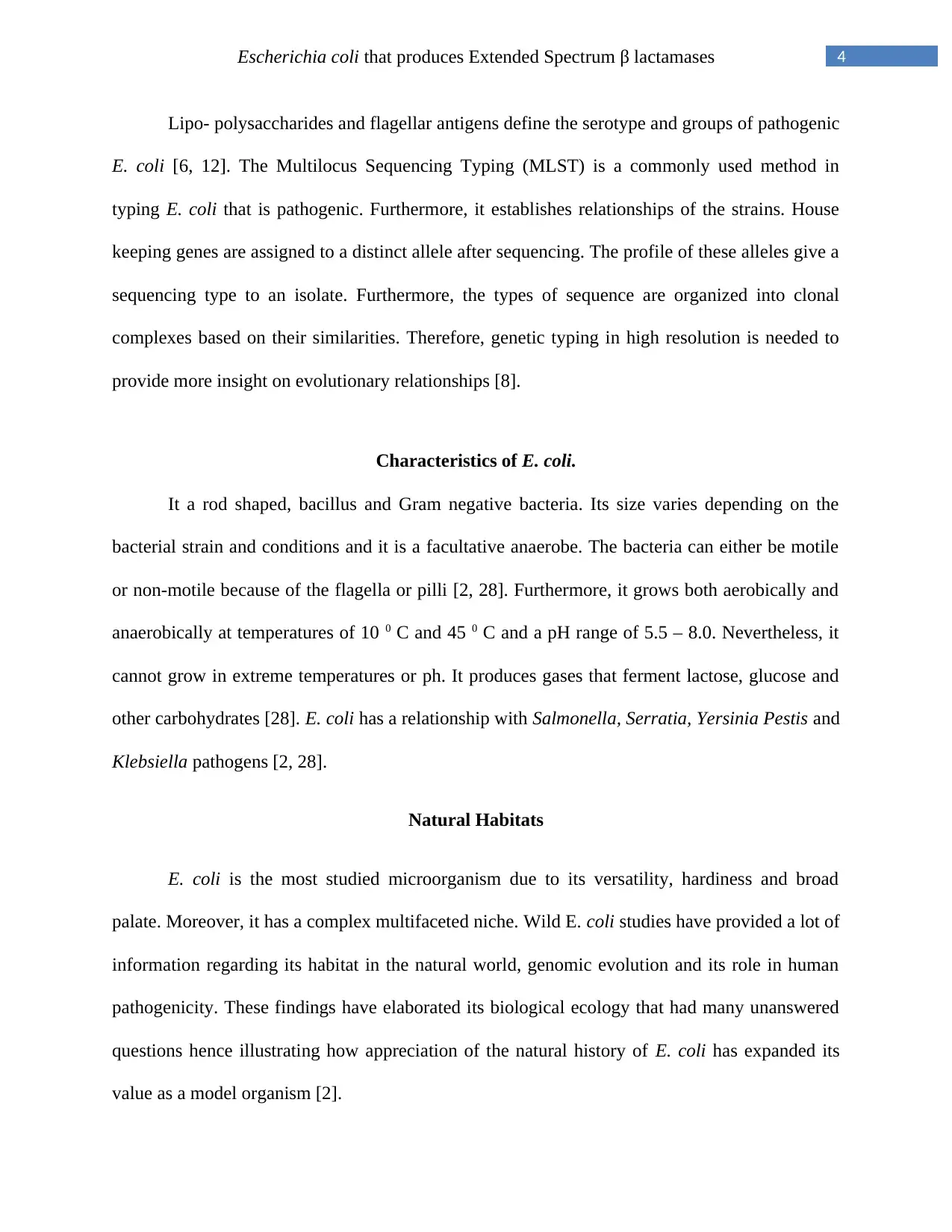
4Escherichia coli that produces Extended Spectrum β lactamases
Lipo- polysaccharides and flagellar antigens define the serotype and groups of pathogenic
E. coli [6, 12]. The Multilocus Sequencing Typing (MLST) is a commonly used method in
typing E. coli that is pathogenic. Furthermore, it establishes relationships of the strains. House
keeping genes are assigned to a distinct allele after sequencing. The profile of these alleles give a
sequencing type to an isolate. Furthermore, the types of sequence are organized into clonal
complexes based on their similarities. Therefore, genetic typing in high resolution is needed to
provide more insight on evolutionary relationships [8].
Characteristics of E. coli.
It a rod shaped, bacillus and Gram negative bacteria. Its size varies depending on the
bacterial strain and conditions and it is a facultative anaerobe. The bacteria can either be motile
or non-motile because of the flagella or pilli [2, 28]. Furthermore, it grows both aerobically and
anaerobically at temperatures of 10 0 C and 45 0 C and a pH range of 5.5 – 8.0. Nevertheless, it
cannot grow in extreme temperatures or ph. It produces gases that ferment lactose, glucose and
other carbohydrates [28]. E. coli has a relationship with Salmonella, Serratia, Yersinia Pestis and
Klebsiella pathogens [2, 28].
Natural Habitats
E. coli is the most studied microorganism due to its versatility, hardiness and broad
palate. Moreover, it has a complex multifaceted niche. Wild E. coli studies have provided a lot of
information regarding its habitat in the natural world, genomic evolution and its role in human
pathogenicity. These findings have elaborated its biological ecology that had many unanswered
questions hence illustrating how appreciation of the natural history of E. coli has expanded its
value as a model organism [2].
Lipo- polysaccharides and flagellar antigens define the serotype and groups of pathogenic
E. coli [6, 12]. The Multilocus Sequencing Typing (MLST) is a commonly used method in
typing E. coli that is pathogenic. Furthermore, it establishes relationships of the strains. House
keeping genes are assigned to a distinct allele after sequencing. The profile of these alleles give a
sequencing type to an isolate. Furthermore, the types of sequence are organized into clonal
complexes based on their similarities. Therefore, genetic typing in high resolution is needed to
provide more insight on evolutionary relationships [8].
Characteristics of E. coli.
It a rod shaped, bacillus and Gram negative bacteria. Its size varies depending on the
bacterial strain and conditions and it is a facultative anaerobe. The bacteria can either be motile
or non-motile because of the flagella or pilli [2, 28]. Furthermore, it grows both aerobically and
anaerobically at temperatures of 10 0 C and 45 0 C and a pH range of 5.5 – 8.0. Nevertheless, it
cannot grow in extreme temperatures or ph. It produces gases that ferment lactose, glucose and
other carbohydrates [28]. E. coli has a relationship with Salmonella, Serratia, Yersinia Pestis and
Klebsiella pathogens [2, 28].
Natural Habitats
E. coli is the most studied microorganism due to its versatility, hardiness and broad
palate. Moreover, it has a complex multifaceted niche. Wild E. coli studies have provided a lot of
information regarding its habitat in the natural world, genomic evolution and its role in human
pathogenicity. These findings have elaborated its biological ecology that had many unanswered
questions hence illustrating how appreciation of the natural history of E. coli has expanded its
value as a model organism [2].
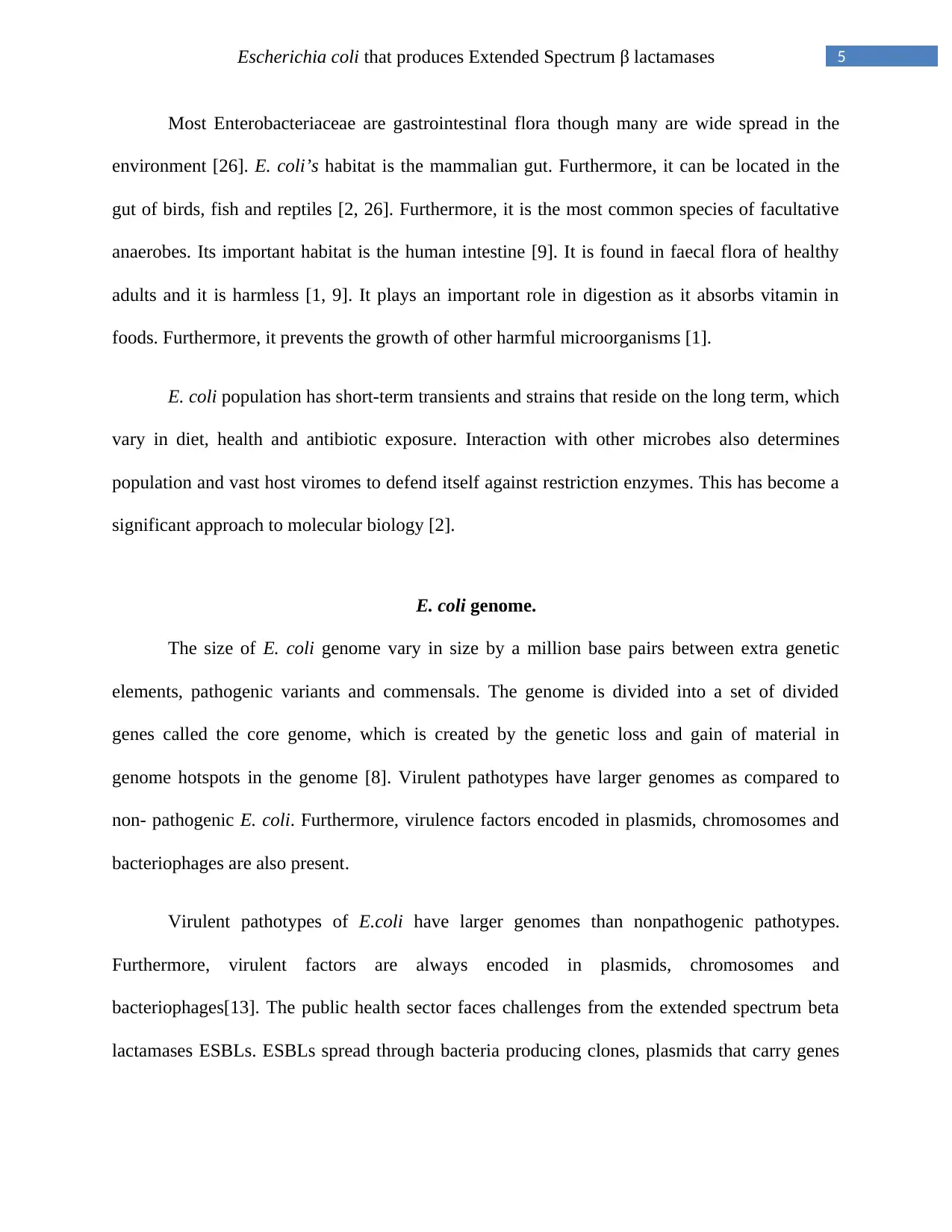
5Escherichia coli that produces Extended Spectrum β lactamases
Most Enterobacteriaceae are gastrointestinal flora though many are wide spread in the
environment [26]. E. coli’s habitat is the mammalian gut. Furthermore, it can be located in the
gut of birds, fish and reptiles [2, 26]. Furthermore, it is the most common species of facultative
anaerobes. Its important habitat is the human intestine [9]. It is found in faecal flora of healthy
adults and it is harmless [1, 9]. It plays an important role in digestion as it absorbs vitamin in
foods. Furthermore, it prevents the growth of other harmful microorganisms [1].
E. coli population has short-term transients and strains that reside on the long term, which
vary in diet, health and antibiotic exposure. Interaction with other microbes also determines
population and vast host viromes to defend itself against restriction enzymes. This has become a
significant approach to molecular biology [2].
E. coli genome.
The size of E. coli genome vary in size by a million base pairs between extra genetic
elements, pathogenic variants and commensals. The genome is divided into a set of divided
genes called the core genome, which is created by the genetic loss and gain of material in
genome hotspots in the genome [8]. Virulent pathotypes have larger genomes as compared to
non- pathogenic E. coli. Furthermore, virulence factors encoded in plasmids, chromosomes and
bacteriophages are also present.
Virulent pathotypes of E.coli have larger genomes than nonpathogenic pathotypes.
Furthermore, virulent factors are always encoded in plasmids, chromosomes and
bacteriophages[13]. The public health sector faces challenges from the extended spectrum beta
lactamases ESBLs. ESBLs spread through bacteria producing clones, plasmids that carry genes
Most Enterobacteriaceae are gastrointestinal flora though many are wide spread in the
environment [26]. E. coli’s habitat is the mammalian gut. Furthermore, it can be located in the
gut of birds, fish and reptiles [2, 26]. Furthermore, it is the most common species of facultative
anaerobes. Its important habitat is the human intestine [9]. It is found in faecal flora of healthy
adults and it is harmless [1, 9]. It plays an important role in digestion as it absorbs vitamin in
foods. Furthermore, it prevents the growth of other harmful microorganisms [1].
E. coli population has short-term transients and strains that reside on the long term, which
vary in diet, health and antibiotic exposure. Interaction with other microbes also determines
population and vast host viromes to defend itself against restriction enzymes. This has become a
significant approach to molecular biology [2].
E. coli genome.
The size of E. coli genome vary in size by a million base pairs between extra genetic
elements, pathogenic variants and commensals. The genome is divided into a set of divided
genes called the core genome, which is created by the genetic loss and gain of material in
genome hotspots in the genome [8]. Virulent pathotypes have larger genomes as compared to
non- pathogenic E. coli. Furthermore, virulence factors encoded in plasmids, chromosomes and
bacteriophages are also present.
Virulent pathotypes of E.coli have larger genomes than nonpathogenic pathotypes.
Furthermore, virulent factors are always encoded in plasmids, chromosomes and
bacteriophages[13]. The public health sector faces challenges from the extended spectrum beta
lactamases ESBLs. ESBLs spread through bacteria producing clones, plasmids that carry genes
⊘ This is a preview!⊘
Do you want full access?
Subscribe today to unlock all pages.

Trusted by 1+ million students worldwide
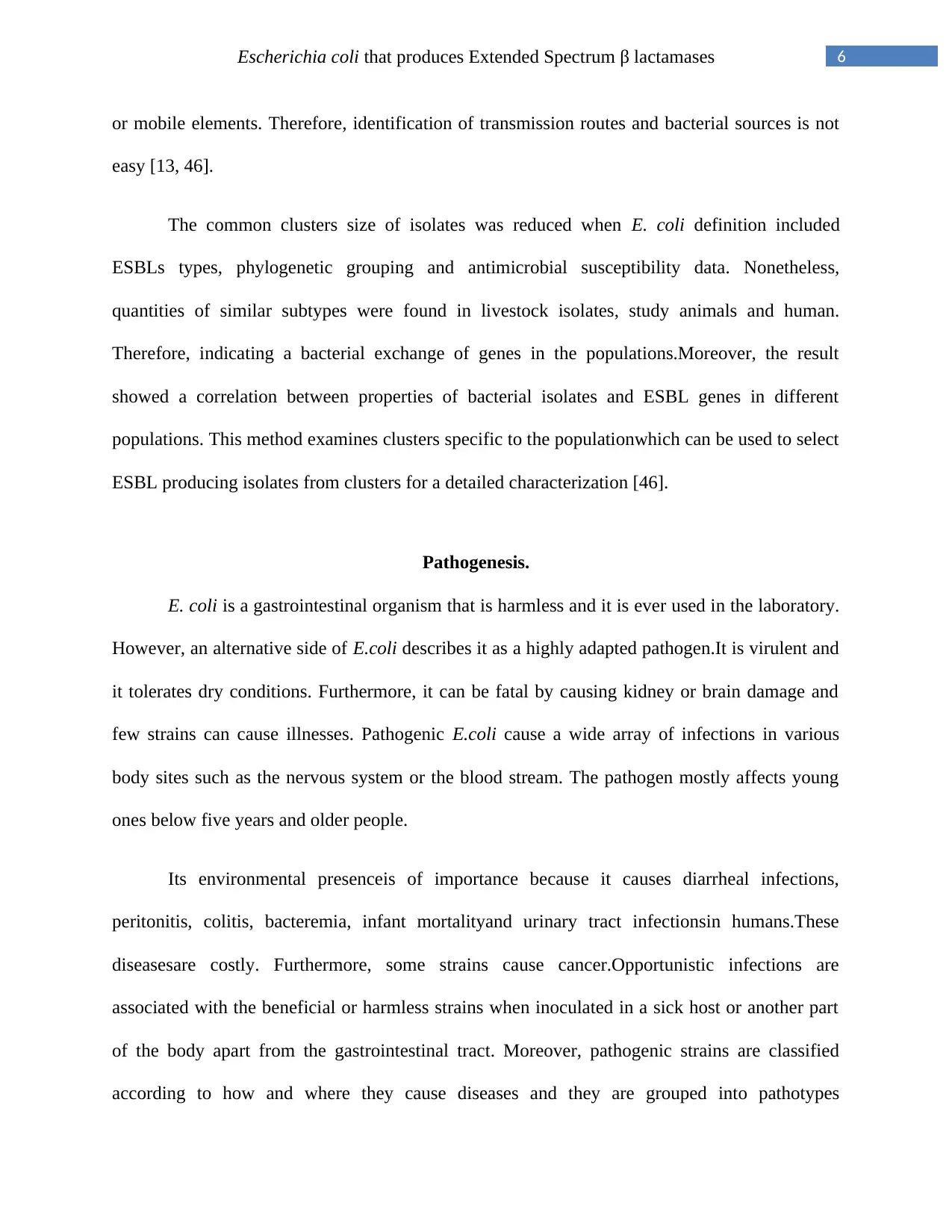
6Escherichia coli that produces Extended Spectrum β lactamases
or mobile elements. Therefore, identification of transmission routes and bacterial sources is not
easy [13, 46].
The common clusters size of isolates was reduced when E. coli definition included
ESBLs types, phylogenetic grouping and antimicrobial susceptibility data. Nonetheless,
quantities of similar subtypes were found in livestock isolates, study animals and human.
Therefore, indicating a bacterial exchange of genes in the populations.Moreover, the result
showed a correlation between properties of bacterial isolates and ESBL genes in different
populations. This method examines clusters specific to the populationwhich can be used to select
ESBL producing isolates from clusters for a detailed characterization [46].
Pathogenesis.
E. coli is a gastrointestinal organism that is harmless and it is ever used in the laboratory.
However, an alternative side of E.coli describes it as a highly adapted pathogen.It is virulent and
it tolerates dry conditions. Furthermore, it can be fatal by causing kidney or brain damage and
few strains can cause illnesses. Pathogenic E.coli cause a wide array of infections in various
body sites such as the nervous system or the blood stream. The pathogen mostly affects young
ones below five years and older people.
Its environmental presenceis of importance because it causes diarrheal infections,
peritonitis, colitis, bacteremia, infant mortalityand urinary tract infectionsin humans.These
diseasesare costly. Furthermore, some strains cause cancer.Opportunistic infections are
associated with the beneficial or harmless strains when inoculated in a sick host or another part
of the body apart from the gastrointestinal tract. Moreover, pathogenic strains are classified
according to how and where they cause diseases and they are grouped into pathotypes
or mobile elements. Therefore, identification of transmission routes and bacterial sources is not
easy [13, 46].
The common clusters size of isolates was reduced when E. coli definition included
ESBLs types, phylogenetic grouping and antimicrobial susceptibility data. Nonetheless,
quantities of similar subtypes were found in livestock isolates, study animals and human.
Therefore, indicating a bacterial exchange of genes in the populations.Moreover, the result
showed a correlation between properties of bacterial isolates and ESBL genes in different
populations. This method examines clusters specific to the populationwhich can be used to select
ESBL producing isolates from clusters for a detailed characterization [46].
Pathogenesis.
E. coli is a gastrointestinal organism that is harmless and it is ever used in the laboratory.
However, an alternative side of E.coli describes it as a highly adapted pathogen.It is virulent and
it tolerates dry conditions. Furthermore, it can be fatal by causing kidney or brain damage and
few strains can cause illnesses. Pathogenic E.coli cause a wide array of infections in various
body sites such as the nervous system or the blood stream. The pathogen mostly affects young
ones below five years and older people.
Its environmental presenceis of importance because it causes diarrheal infections,
peritonitis, colitis, bacteremia, infant mortalityand urinary tract infectionsin humans.These
diseasesare costly. Furthermore, some strains cause cancer.Opportunistic infections are
associated with the beneficial or harmless strains when inoculated in a sick host or another part
of the body apart from the gastrointestinal tract. Moreover, pathogenic strains are classified
according to how and where they cause diseases and they are grouped into pathotypes
Paraphrase This Document
Need a fresh take? Get an instant paraphrase of this document with our AI Paraphraser
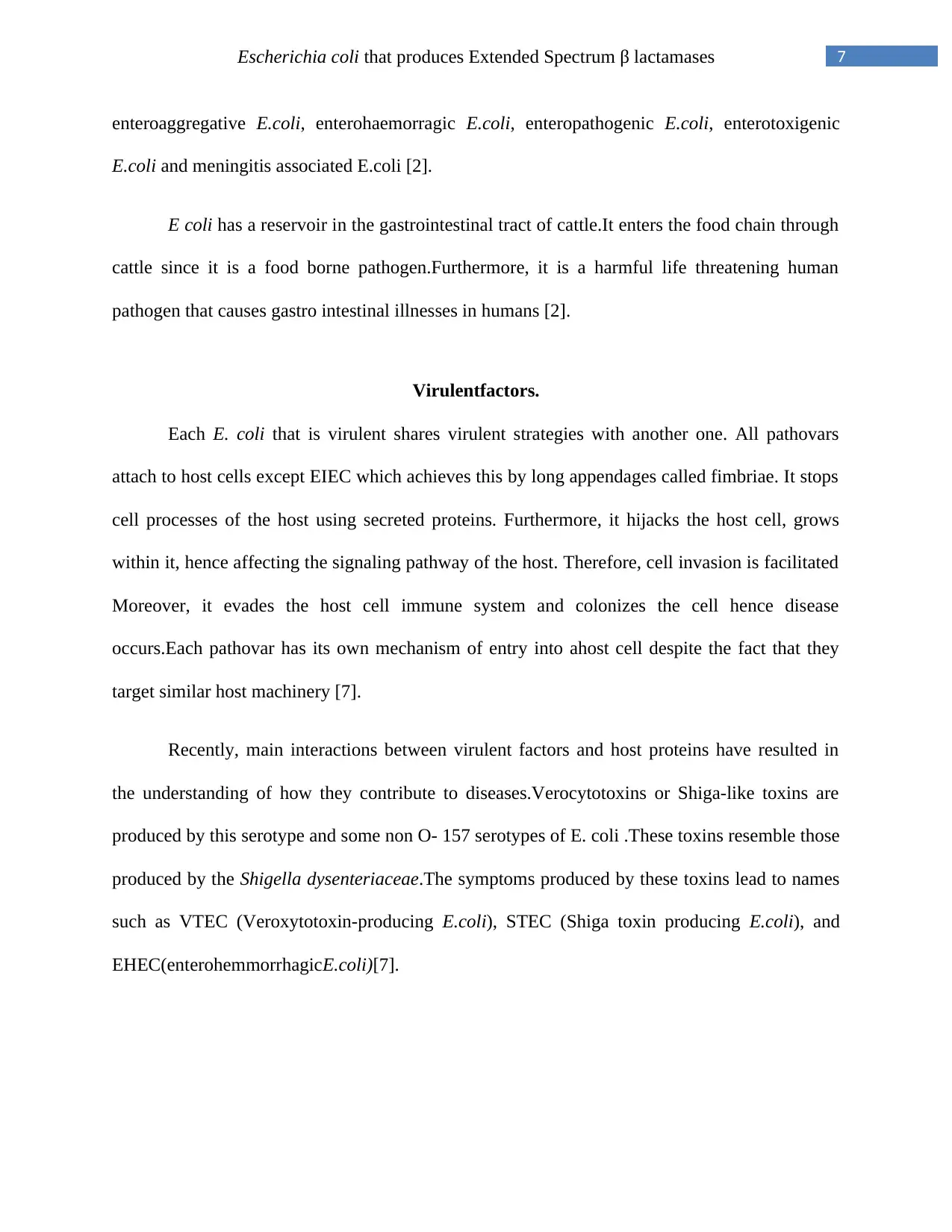
7Escherichia coli that produces Extended Spectrum β lactamases
enteroaggregative E.coli, enterohaemorragic E.coli, enteropathogenic E.coli, enterotoxigenic
E.coli and meningitis associated E.coli [2].
E coli has a reservoir in the gastrointestinal tract of cattle.It enters the food chain through
cattle since it is a food borne pathogen.Furthermore, it is a harmful life threatening human
pathogen that causes gastro intestinal illnesses in humans [2].
Virulentfactors.
Each E. coli that is virulent shares virulent strategies with another one. All pathovars
attach to host cells except EIEC which achieves this by long appendages called fimbriae. It stops
cell processes of the host using secreted proteins. Furthermore, it hijacks the host cell, grows
within it, hence affecting the signaling pathway of the host. Therefore, cell invasion is facilitated
Moreover, it evades the host cell immune system and colonizes the cell hence disease
occurs.Each pathovar has its own mechanism of entry into ahost cell despite the fact that they
target similar host machinery [7].
Recently, main interactions between virulent factors and host proteins have resulted in
the understanding of how they contribute to diseases.Verocytotoxins or Shiga-like toxins are
produced by this serotype and some non O- 157 serotypes of E. coli .These toxins resemble those
produced by the Shigella dysenteriaceae.The symptoms produced by these toxins lead to names
such as VTEC (Veroxytotoxin-producing E.coli), STEC (Shiga toxin producing E.coli), and
EHEC(enterohemmorrhagicE.coli)[7].
enteroaggregative E.coli, enterohaemorragic E.coli, enteropathogenic E.coli, enterotoxigenic
E.coli and meningitis associated E.coli [2].
E coli has a reservoir in the gastrointestinal tract of cattle.It enters the food chain through
cattle since it is a food borne pathogen.Furthermore, it is a harmful life threatening human
pathogen that causes gastro intestinal illnesses in humans [2].
Virulentfactors.
Each E. coli that is virulent shares virulent strategies with another one. All pathovars
attach to host cells except EIEC which achieves this by long appendages called fimbriae. It stops
cell processes of the host using secreted proteins. Furthermore, it hijacks the host cell, grows
within it, hence affecting the signaling pathway of the host. Therefore, cell invasion is facilitated
Moreover, it evades the host cell immune system and colonizes the cell hence disease
occurs.Each pathovar has its own mechanism of entry into ahost cell despite the fact that they
target similar host machinery [7].
Recently, main interactions between virulent factors and host proteins have resulted in
the understanding of how they contribute to diseases.Verocytotoxins or Shiga-like toxins are
produced by this serotype and some non O- 157 serotypes of E. coli .These toxins resemble those
produced by the Shigella dysenteriaceae.The symptoms produced by these toxins lead to names
such as VTEC (Veroxytotoxin-producing E.coli), STEC (Shiga toxin producing E.coli), and
EHEC(enterohemmorrhagicE.coli)[7].
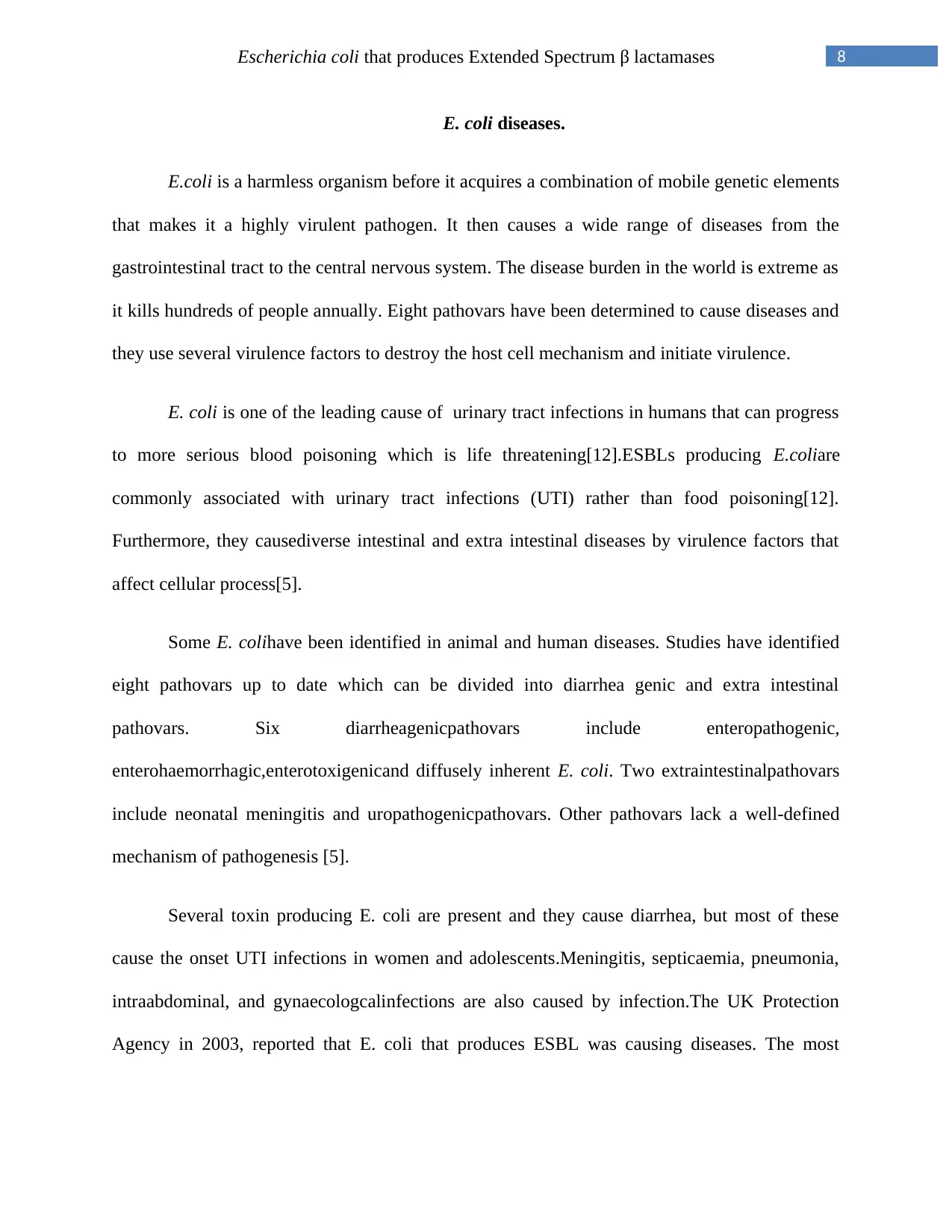
8Escherichia coli that produces Extended Spectrum β lactamases
E. coli diseases.
E.coli is a harmless organism before it acquires a combination of mobile genetic elements
that makes it a highly virulent pathogen. It then causes a wide range of diseases from the
gastrointestinal tract to the central nervous system. The disease burden in the world is extreme as
it kills hundreds of people annually. Eight pathovars have been determined to cause diseases and
they use several virulence factors to destroy the host cell mechanism and initiate virulence.
E. coli is one of the leading cause of urinary tract infections in humans that can progress
to more serious blood poisoning which is life threatening[12].ESBLs producing E.coliare
commonly associated with urinary tract infections (UTI) rather than food poisoning[12].
Furthermore, they causediverse intestinal and extra intestinal diseases by virulence factors that
affect cellular process[5].
Some E. colihave been identified in animal and human diseases. Studies have identified
eight pathovars up to date which can be divided into diarrhea genic and extra intestinal
pathovars. Six diarrheagenicpathovars include enteropathogenic,
enterohaemorrhagic,enterotoxigenicand diffusely inherent E. coli. Two extraintestinalpathovars
include neonatal meningitis and uropathogenicpathovars. Other pathovars lack a well-defined
mechanism of pathogenesis [5].
Several toxin producing E. coli are present and they cause diarrhea, but most of these
cause the onset UTI infections in women and adolescents.Meningitis, septicaemia, pneumonia,
intraabdominal, and gynaecologcalinfections are also caused by infection.The UK Protection
Agency in 2003, reported that E. coli that produces ESBL was causing diseases. The most
E. coli diseases.
E.coli is a harmless organism before it acquires a combination of mobile genetic elements
that makes it a highly virulent pathogen. It then causes a wide range of diseases from the
gastrointestinal tract to the central nervous system. The disease burden in the world is extreme as
it kills hundreds of people annually. Eight pathovars have been determined to cause diseases and
they use several virulence factors to destroy the host cell mechanism and initiate virulence.
E. coli is one of the leading cause of urinary tract infections in humans that can progress
to more serious blood poisoning which is life threatening[12].ESBLs producing E.coliare
commonly associated with urinary tract infections (UTI) rather than food poisoning[12].
Furthermore, they causediverse intestinal and extra intestinal diseases by virulence factors that
affect cellular process[5].
Some E. colihave been identified in animal and human diseases. Studies have identified
eight pathovars up to date which can be divided into diarrhea genic and extra intestinal
pathovars. Six diarrheagenicpathovars include enteropathogenic,
enterohaemorrhagic,enterotoxigenicand diffusely inherent E. coli. Two extraintestinalpathovars
include neonatal meningitis and uropathogenicpathovars. Other pathovars lack a well-defined
mechanism of pathogenesis [5].
Several toxin producing E. coli are present and they cause diarrhea, but most of these
cause the onset UTI infections in women and adolescents.Meningitis, septicaemia, pneumonia,
intraabdominal, and gynaecologcalinfections are also caused by infection.The UK Protection
Agency in 2003, reported that E. coli that produces ESBL was causing diseases. The most
⊘ This is a preview!⊘
Do you want full access?
Subscribe today to unlock all pages.

Trusted by 1+ million students worldwide
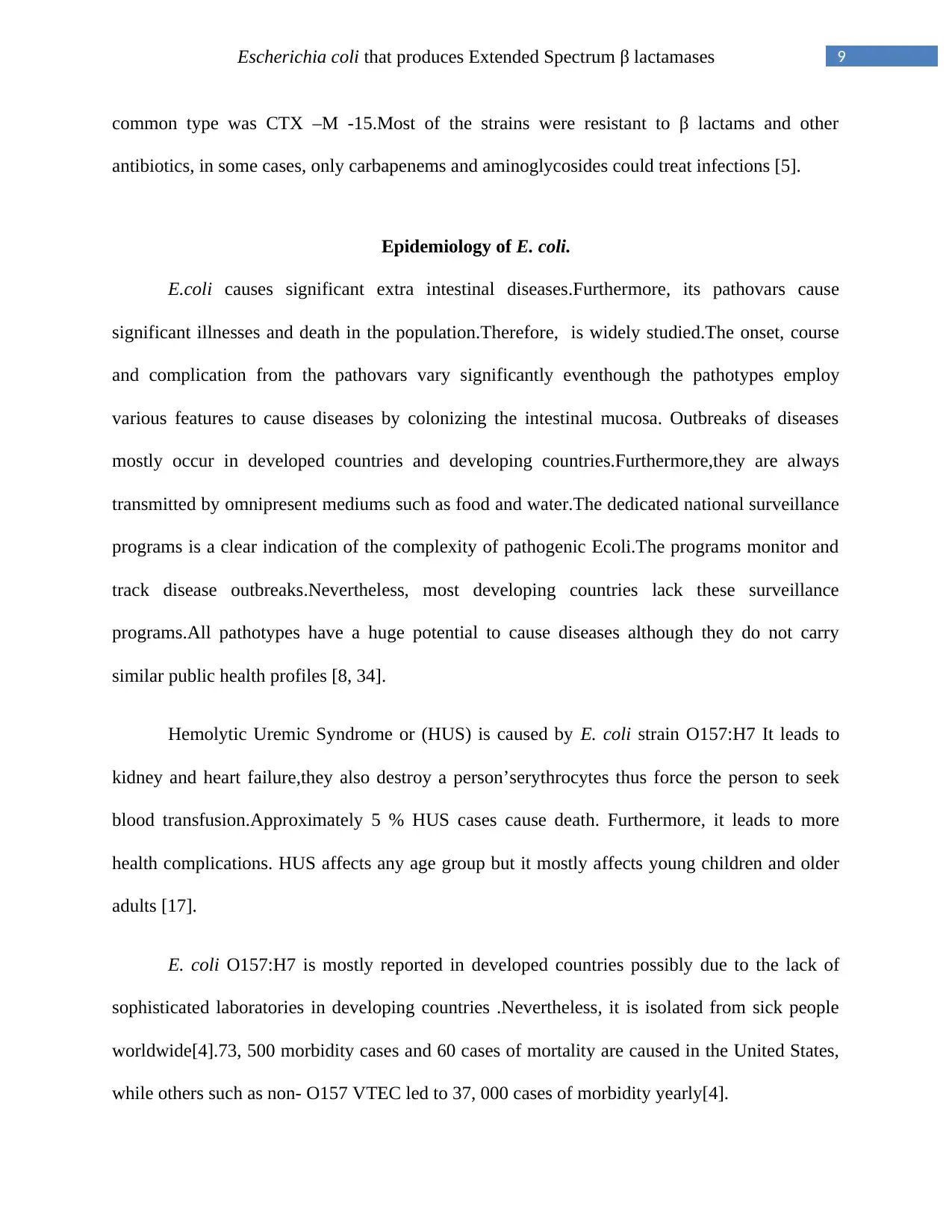
9Escherichia coli that produces Extended Spectrum β lactamases
common type was CTX –M -15.Most of the strains were resistant to β lactams and other
antibiotics, in some cases, only carbapenems and aminoglycosides could treat infections [5].
Epidemiology of E. coli.
E.coli causes significant extra intestinal diseases.Furthermore, its pathovars cause
significant illnesses and death in the population.Therefore, is widely studied.The onset, course
and complication from the pathovars vary significantly eventhough the pathotypes employ
various features to cause diseases by colonizing the intestinal mucosa. Outbreaks of diseases
mostly occur in developed countries and developing countries.Furthermore,they are always
transmitted by omnipresent mediums such as food and water.The dedicated national surveillance
programs is a clear indication of the complexity of pathogenic Ecoli.The programs monitor and
track disease outbreaks.Nevertheless, most developing countries lack these surveillance
programs.All pathotypes have a huge potential to cause diseases although they do not carry
similar public health profiles [8, 34].
Hemolytic Uremic Syndrome or (HUS) is caused by E. coli strain O157:H7 It leads to
kidney and heart failure,they also destroy a person’serythrocytes thus force the person to seek
blood transfusion.Approximately 5 % HUS cases cause death. Furthermore, it leads to more
health complications. HUS affects any age group but it mostly affects young children and older
adults [17].
E. coli O157:H7 is mostly reported in developed countries possibly due to the lack of
sophisticated laboratories in developing countries .Nevertheless, it is isolated from sick people
worldwide[4].73, 500 morbidity cases and 60 cases of mortality are caused in the United States,
while others such as non- O157 VTEC led to 37, 000 cases of morbidity yearly[4].
common type was CTX –M -15.Most of the strains were resistant to β lactams and other
antibiotics, in some cases, only carbapenems and aminoglycosides could treat infections [5].
Epidemiology of E. coli.
E.coli causes significant extra intestinal diseases.Furthermore, its pathovars cause
significant illnesses and death in the population.Therefore, is widely studied.The onset, course
and complication from the pathovars vary significantly eventhough the pathotypes employ
various features to cause diseases by colonizing the intestinal mucosa. Outbreaks of diseases
mostly occur in developed countries and developing countries.Furthermore,they are always
transmitted by omnipresent mediums such as food and water.The dedicated national surveillance
programs is a clear indication of the complexity of pathogenic Ecoli.The programs monitor and
track disease outbreaks.Nevertheless, most developing countries lack these surveillance
programs.All pathotypes have a huge potential to cause diseases although they do not carry
similar public health profiles [8, 34].
Hemolytic Uremic Syndrome or (HUS) is caused by E. coli strain O157:H7 It leads to
kidney and heart failure,they also destroy a person’serythrocytes thus force the person to seek
blood transfusion.Approximately 5 % HUS cases cause death. Furthermore, it leads to more
health complications. HUS affects any age group but it mostly affects young children and older
adults [17].
E. coli O157:H7 is mostly reported in developed countries possibly due to the lack of
sophisticated laboratories in developing countries .Nevertheless, it is isolated from sick people
worldwide[4].73, 500 morbidity cases and 60 cases of mortality are caused in the United States,
while others such as non- O157 VTEC led to 37, 000 cases of morbidity yearly[4].
Paraphrase This Document
Need a fresh take? Get an instant paraphrase of this document with our AI Paraphraser
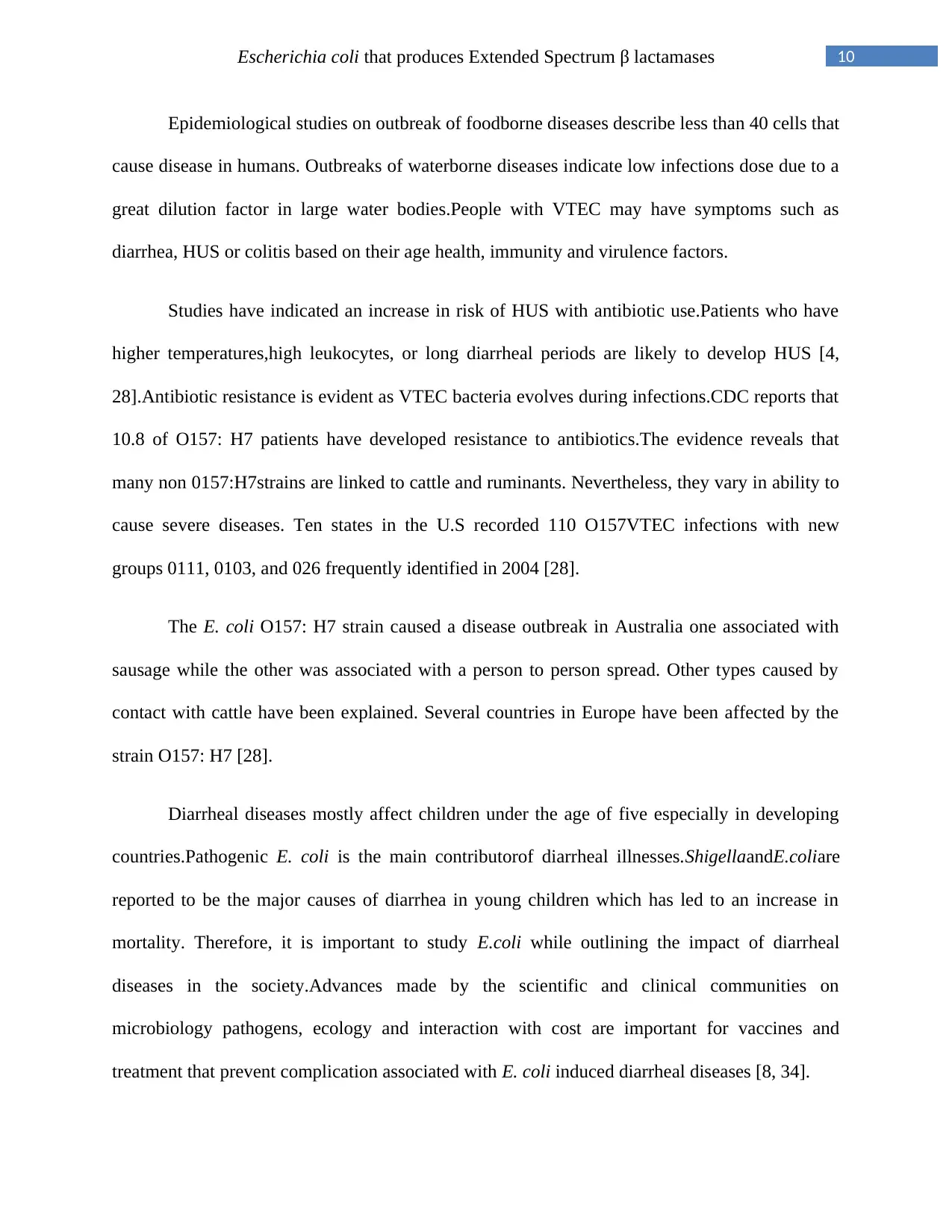
10Escherichia coli that produces Extended Spectrum β lactamases
Epidemiological studies on outbreak of foodborne diseases describe less than 40 cells that
cause disease in humans. Outbreaks of waterborne diseases indicate low infections dose due to a
great dilution factor in large water bodies.People with VTEC may have symptoms such as
diarrhea, HUS or colitis based on their age health, immunity and virulence factors.
Studies have indicated an increase in risk of HUS with antibiotic use.Patients who have
higher temperatures,high leukocytes, or long diarrheal periods are likely to develop HUS [4,
28].Antibiotic resistance is evident as VTEC bacteria evolves during infections.CDC reports that
10.8 of O157: H7 patients have developed resistance to antibiotics.The evidence reveals that
many non 0157:H7strains are linked to cattle and ruminants. Nevertheless, they vary in ability to
cause severe diseases. Ten states in the U.S recorded 110 O157VTEC infections with new
groups 0111, 0103, and 026 frequently identified in 2004 [28].
The E. coli O157: H7 strain caused a disease outbreak in Australia one associated with
sausage while the other was associated with a person to person spread. Other types caused by
contact with cattle have been explained. Several countries in Europe have been affected by the
strain O157: H7 [28].
Diarrheal diseases mostly affect children under the age of five especially in developing
countries.Pathogenic E. coli is the main contributorof diarrheal illnesses.ShigellaandE.coliare
reported to be the major causes of diarrhea in young children which has led to an increase in
mortality. Therefore, it is important to study E.coli while outlining the impact of diarrheal
diseases in the society.Advances made by the scientific and clinical communities on
microbiology pathogens, ecology and interaction with cost are important for vaccines and
treatment that prevent complication associated with E. coli induced diarrheal diseases [8, 34].
Epidemiological studies on outbreak of foodborne diseases describe less than 40 cells that
cause disease in humans. Outbreaks of waterborne diseases indicate low infections dose due to a
great dilution factor in large water bodies.People with VTEC may have symptoms such as
diarrhea, HUS or colitis based on their age health, immunity and virulence factors.
Studies have indicated an increase in risk of HUS with antibiotic use.Patients who have
higher temperatures,high leukocytes, or long diarrheal periods are likely to develop HUS [4,
28].Antibiotic resistance is evident as VTEC bacteria evolves during infections.CDC reports that
10.8 of O157: H7 patients have developed resistance to antibiotics.The evidence reveals that
many non 0157:H7strains are linked to cattle and ruminants. Nevertheless, they vary in ability to
cause severe diseases. Ten states in the U.S recorded 110 O157VTEC infections with new
groups 0111, 0103, and 026 frequently identified in 2004 [28].
The E. coli O157: H7 strain caused a disease outbreak in Australia one associated with
sausage while the other was associated with a person to person spread. Other types caused by
contact with cattle have been explained. Several countries in Europe have been affected by the
strain O157: H7 [28].
Diarrheal diseases mostly affect children under the age of five especially in developing
countries.Pathogenic E. coli is the main contributorof diarrheal illnesses.ShigellaandE.coliare
reported to be the major causes of diarrhea in young children which has led to an increase in
mortality. Therefore, it is important to study E.coli while outlining the impact of diarrheal
diseases in the society.Advances made by the scientific and clinical communities on
microbiology pathogens, ecology and interaction with cost are important for vaccines and
treatment that prevent complication associated with E. coli induced diarrheal diseases [8, 34].
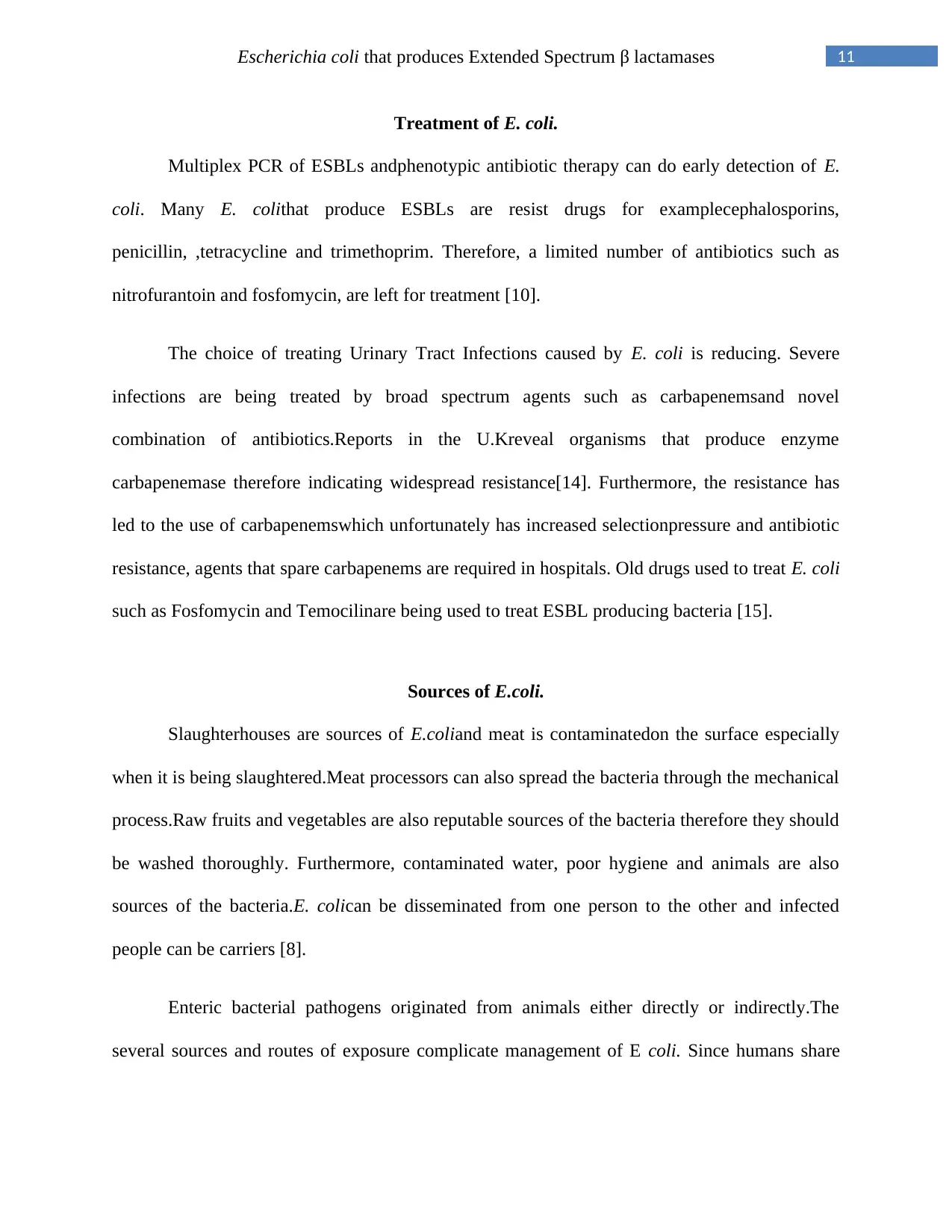
11Escherichia coli that produces Extended Spectrum β lactamases
Treatment of E. coli.
Multiplex PCR of ESBLs andphenotypic antibiotic therapy can do early detection of E.
coli. Many E. colithat produce ESBLs are resist drugs for examplecephalosporins,
penicillin, ,tetracycline and trimethoprim. Therefore, a limited number of antibiotics such as
nitrofurantoin and fosfomycin, are left for treatment [10].
The choice of treating Urinary Tract Infections caused by E. coli is reducing. Severe
infections are being treated by broad spectrum agents such as carbapenemsand novel
combination of antibiotics.Reports in the U.Kreveal organisms that produce enzyme
carbapenemase therefore indicating widespread resistance[14]. Furthermore, the resistance has
led to the use of carbapenemswhich unfortunately has increased selectionpressure and antibiotic
resistance, agents that spare carbapenems are required in hospitals. Old drugs used to treat E. coli
such as Fosfomycin and Temocilinare being used to treat ESBL producing bacteria [15].
Sources of E.coli.
Slaughterhouses are sources of E.coliand meat is contaminatedon the surface especially
when it is being slaughtered.Meat processors can also spread the bacteria through the mechanical
process.Raw fruits and vegetables are also reputable sources of the bacteria therefore they should
be washed thoroughly. Furthermore, contaminated water, poor hygiene and animals are also
sources of the bacteria.E. colican be disseminated from one person to the other and infected
people can be carriers [8].
Enteric bacterial pathogens originated from animals either directly or indirectly.The
several sources and routes of exposure complicate management of E coli. Since humans share
Treatment of E. coli.
Multiplex PCR of ESBLs andphenotypic antibiotic therapy can do early detection of E.
coli. Many E. colithat produce ESBLs are resist drugs for examplecephalosporins,
penicillin, ,tetracycline and trimethoprim. Therefore, a limited number of antibiotics such as
nitrofurantoin and fosfomycin, are left for treatment [10].
The choice of treating Urinary Tract Infections caused by E. coli is reducing. Severe
infections are being treated by broad spectrum agents such as carbapenemsand novel
combination of antibiotics.Reports in the U.Kreveal organisms that produce enzyme
carbapenemase therefore indicating widespread resistance[14]. Furthermore, the resistance has
led to the use of carbapenemswhich unfortunately has increased selectionpressure and antibiotic
resistance, agents that spare carbapenems are required in hospitals. Old drugs used to treat E. coli
such as Fosfomycin and Temocilinare being used to treat ESBL producing bacteria [15].
Sources of E.coli.
Slaughterhouses are sources of E.coliand meat is contaminatedon the surface especially
when it is being slaughtered.Meat processors can also spread the bacteria through the mechanical
process.Raw fruits and vegetables are also reputable sources of the bacteria therefore they should
be washed thoroughly. Furthermore, contaminated water, poor hygiene and animals are also
sources of the bacteria.E. colican be disseminated from one person to the other and infected
people can be carriers [8].
Enteric bacterial pathogens originated from animals either directly or indirectly.The
several sources and routes of exposure complicate management of E coli. Since humans share
⊘ This is a preview!⊘
Do you want full access?
Subscribe today to unlock all pages.

Trusted by 1+ million students worldwide
1 out of 38
Your All-in-One AI-Powered Toolkit for Academic Success.
+13062052269
info@desklib.com
Available 24*7 on WhatsApp / Email
![[object Object]](/_next/static/media/star-bottom.7253800d.svg)
Unlock your academic potential
Copyright © 2020–2025 A2Z Services. All Rights Reserved. Developed and managed by ZUCOL.

